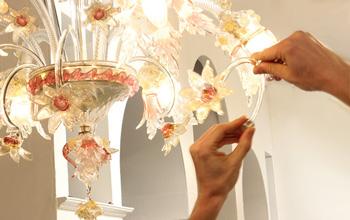How venetian glass is made from the chemical elements, in this article we share some knowledge about Murano glass making
A world over seven centuries old
The Murano glass art work has its roots in 1291 when, by decree of the Serenissima Republic, all the furnaces of Venice were moved in that island. From then on, as in the slow disentangling of a thread through the centuries, this activity has thrived reaching excelled creative heights and developing methods, techniques and tools without ever betraying its identity. Behind the glass is grown a real world unique and unrepeatable, made of fatigue, hands moving deftly, glances that run from the heat of the melting furnaces to the water used to cool the material, patience and rapidity of execution, suggestions and sayings forged by the long hours that glass masters and assistants have spent together working shoulder to shoulder, day after day.At the center of everything: what is the "partìa"?
At the base of this magic there is a fitting composition of elements, known as "partia", a sharp combination of substances that, depending on type and dosage of each ingredient, can open to the artist or craftsman an almost unlimited range of chromatic possibilities. There are four basic components:
1) Silica sand, which alone would melt at around 1750 degrees resulting therefore practically impossible to manage
2) Soda, precisely used to lower the melting temperature, in a range that from about 1400 degrees can fall further and further
3) Calcium carbonate, element used to prevent from the natural matting effect of soda in motion within the viscous liquid of the vitreous mass
4) Rinse aid, usually antimony, which has the mean of getting faster clean and erasing small impurities.
To develop this basic composition - that lastly would become crystal glass - in order to obtain from the material the desired color tone come into play oxides, chemical elements one by one associated with a determined chromatic gradient.
To get the yellow you must use the right amount of cadmium, selenium for the red, cobalt for the blue, copper flake for the green, cadmium and a part of selenium (mixture of oxides corresponding to the two primary colors yellow and red) for the orange, a little part of manganese for the purple amethyst, a bigger one for the black.
Fusion in furnace, the magic explained phase by phase from the inside
The glass melting process can be considered the heart of what is the tradition of the artistic glass of Murano, the starting point from which branch off all the specific techniques that will be analyzed in the next few texts. Procedures remained the same over the centuries, innovations in instrumentation, scientific nomenclature and lively jargon used by workers advance together in an extraordinary dance that swirls inside a world that deserves to be discovered.
1) Metal crucibles of different sizes are used to contain the composition of elements and to accommodate the melting step: the larger crucible is called "Palato", the smaller ones "Ninfe" and those of still lesser extent " Ninfette". A fresh production crucible cannot be used immediately, it should be accustomed within the furnace to a heat gradually increasing that will bring it, in a matter of a week or a little more, to be able to withstand temperatures that can reach 1400 degrees.
2) Once the depositing operation of the Palato on the bottom of the oven had a specific name, the so-called "Calada". In fact, the period of preparation for the heat took place [in fact] on top of four glass stones (in order to put under thermal stress the entire crucible, also the part below) that did not melt again: hence it was [therefore] necessary to use a hook and a jemmy for moving the four bases and slowly accompanying the Palato until it touched the base of the oven. An evolution of this delicate and difficult operation, that could involve four man given the weight of the crucible, was the introduction of glassy rocks that could melt gradually, so as to gradually bring the Palato to recline on the bottom.
3) Another practice, which is useful as an additional protective measure for the crucibles that must withstand the highest temperatures, is called "Invariatura", the application of crystal glass along the inner walls of the crucible, so as to obtain a vitreous coating for the protection of metal surface.
4) At this point, when they are ready for the fundamental "First fusion", in the composition that you want to melt it is added the "Rottura", scrap elements of the same chemical type derivatived from previous mergers that facilitate the unfolding of what you want to get . From the second fusion onwards it will always be kept a waste fund, the Rottura precisely, inside the crucible, and will no longer need to add Rottura from the outside.












